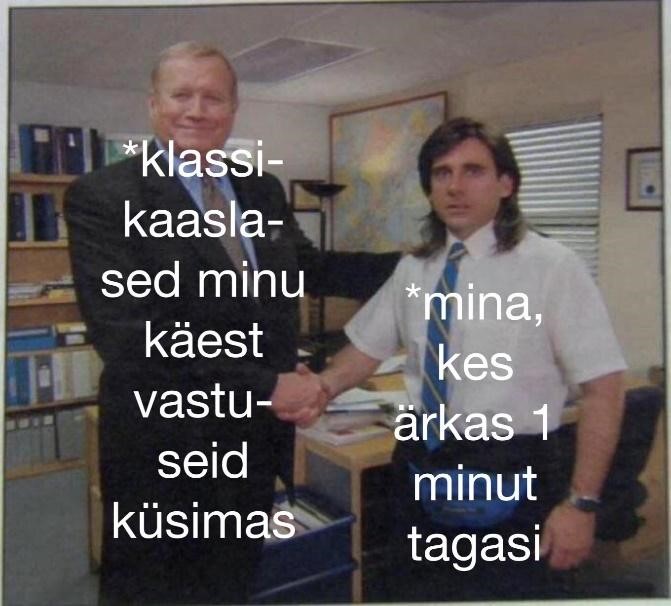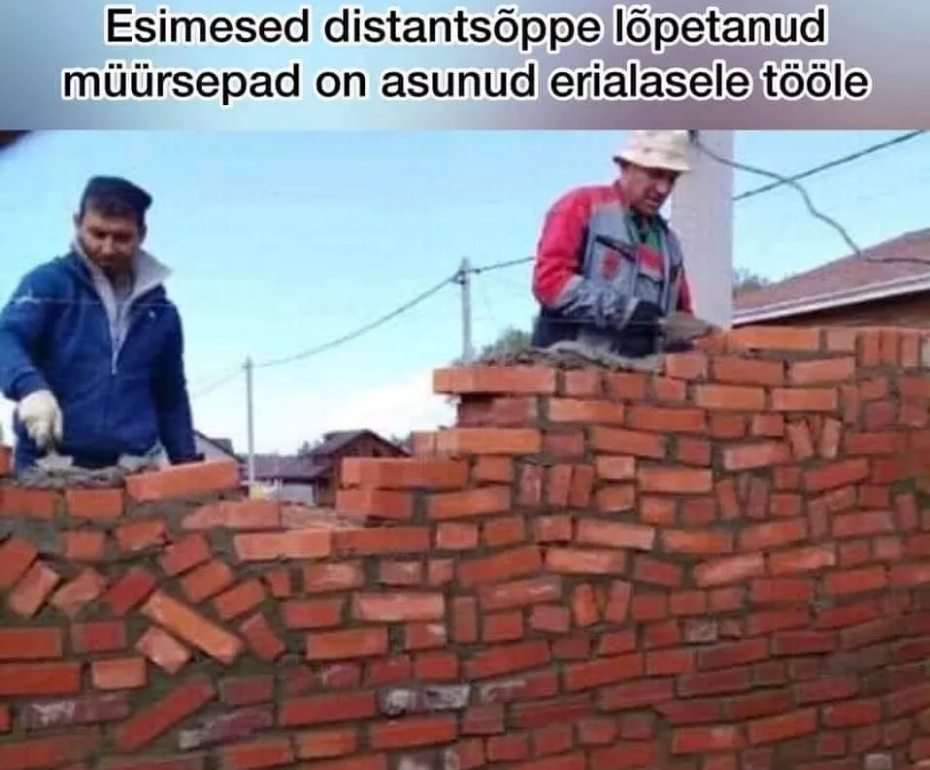What do young people do when they get stressed? Memes! Estonian folklorists zoomed in on them.
Two construction workers are building a wall. If you look more closely, the bricks laid are entirely uneven. They are doing a terrible job. “Bricklayers at work after distance learning,” explains a text above the photo. It could be seen as a silly picture, but Estonian folklore researchers know that memes tell a story that is worth exploring.
Each crisis brings with it a new wave of memes; these emotional outbursts are often funny, insightful and sometimes just relatable. The COVID-19 pandemic is a fascinating one because students all over the world share the same reality: learning online.
Before the Internet was available, people used to tell stories to each other. Remember A Man Walks into a Bar jokes or elephant riddles? They are usually built on the same template used repeatedly, just like modern parallels. Memes have similar roots and reasons. The texts play with stereotypes and familiar life situations that one can relate to.
“The bigger the crisis, the more study material we have,” said Piret Voolaid, the senior researcher at the Estonian Literary Museum. “Memes help us release tensions in times of crisis. People express their fears and emotions through humour, as they always have.”
The literary museum collected over a thousand memes from Estonian schools and analysed them to see what the children experienced during the lockdown.
Creating memes is easier than ever. There are plenty of meme generators and online environments to use. The problem lies in how to gather them. Many memes are shared privately, and researchers don’t have access to them. In this case, the students were asked to share them themselves.

Voolaid has been researching humour for three decades. Her research interests include minor folklore forms like riddles, proverbs, children’s and youth folklore, Internet, and sports lore. She is the author of more than 50 scholarly publications. She has seen jokes so many times that they do not make her laugh anymore, she admits with a smirk. “I just take the joke apart in my mind, trying to understand the reasons and the logic behind it.”
Voolaid summarised how young people saw distance learning through memes in her article.
“The memes show that the students fell into the role of a trickster who tried to fool others,” she said. “Even if tricksters are intelligent and well-intended, they must deal with difficult situations.”
Memes don’t always tell us the problem directly, but they can be understood. For instance, if the student doesn’t own a computer or a student couldn’t get into the online lesson, a meme would help release the tension through humour. “It helps when the student is alone with their worries,” Voolaid said.

* Me, who just woke up a minute ago
The study showed a constant dilemma between what the students should do and what they actually do. There was an urge to get away with not following orders. Napping and sleeping were the most preferred activities for students. Memes can also act as masks to cover the person behind them or how they feel.
One could presume that students were happy to stay at home and not go to school, but the memes suggest they were missing their old learning setting. They wanted things to go back to the way they were.
Besides school life, memes reflected on the role of parents during the pandemic. Many illustrated fed-up adults. Sometimes the parent took over the trickster’s part to cope with the problematic situation.
Teachers in the memes remained focused on schoolwork. Humorously portraying a teacher gives the students a feeling of superiority, Voolaid explains. It’s vital for the process of de-stressing and soothing a person’s well-being, she concluded in the study. “Memes about distance learning help to cope with the growing pains of these young people and with different realities, and act as a valve in a crisis to relieve tension.” Voolaid wrote.
European frontrunners in humour studies
Even if Estonians are not globally known for their sense of humour, they are active when it comes to humour studies. They are often invited to international conferences and academic circles to share the latest knowledge. Voolaid and her colleague Liisi Laineste have published their articles in the European Journal of Humour Research, and both are members of the International Society of Humour Studies.
“The beauty of a meme is the communication and the variability. Anyone can create the meme, and anyone can be the audience,” Laineste said during a discussion about memes at the annual Estonian Opinion Festival. Rainis Pajumäe, one of the most famous Estonian meme-creators, summed it up: “Memes are about creating a community with its codes and language.”
It seems the young people of today’s world are on to something. Whether or not memes make you laugh, they are a great way to release tension and create a sense of a group and community. They are also definitely a healthier choice than vices, and are a lot cheaper than therapy!
Written by: Marian Männi
This article was funded by the European Regional Development Fund through Estonian Research Council.
 Back
Back



